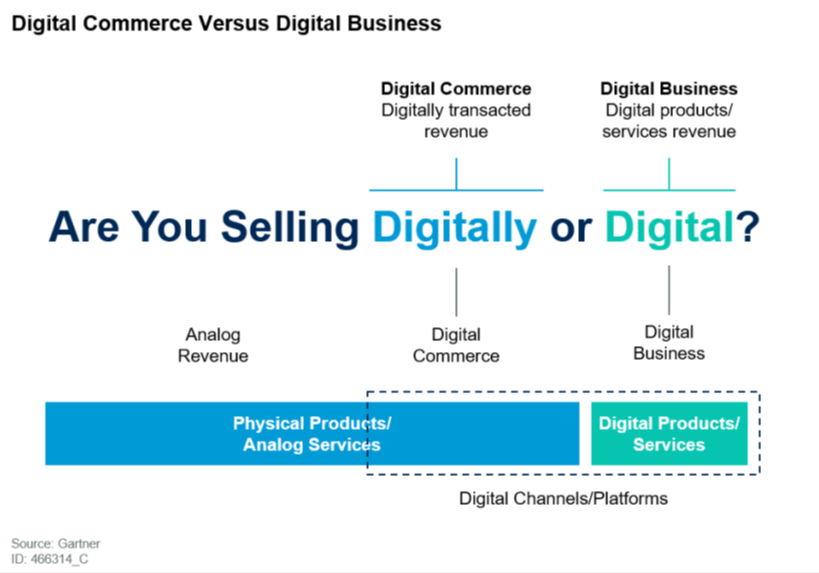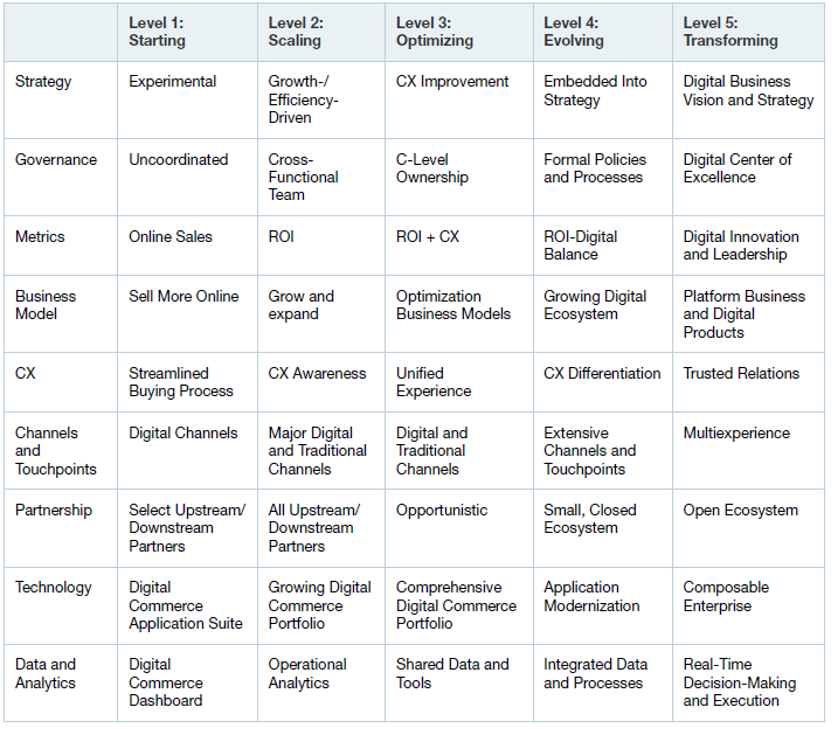By: Sandy Shen, VP Analyst at Gartner
Organizations that have invested more heavily in digital commerce often use digital commerce as a steppingstone to embark on the digital transformation journey. When done right, digitally advanced organizations see digital commerce contribute to a majority of total sales. This can infuse confidence in the organization to further invest in digital business. Digital commerce assets such as business models, partner ecosystems, CX, technology platforms and governance can be leveraged by digital business. At the same time, digital commerce is not the same as digital business, in that digital commerce sells existing products digitally while digital business creates new revenue/value from digital products and services (see Figure 1). Digital business may also involve business model change to support the creation of new revenue/value.
Figure 1. Digital Commerce Versus Digital Business

When organizations reach high maturity (i.e., Level 5), they will start to morph digital commerce into digital business. This is not to say that they will start digital business at a lower maturity, but rather will move into mid-to-high maturity in digital business. This is because digital commerce prepares organizations in digital strategy, business model, CX and technologies, assets they need for digital business so that not only higher maturity in digital commerce makes an easy transition into digital business, but also organizations will start at relatively high maturity for digital business. To digitally transform the business, organizations will increase revenue/margin contribution from digital products and services to an optimal blend to balance digital and traditional capabilities.
When organizations are in lower maturity (e.g., Levels 1 and 2) in digital commerce, they will focus on financial benefits such as revenue growth and cost savings from selling existing analog products. When they move up to higher maturity (e.g., Levels 3 and 4), they will increasingly measure CX as a key performance metric.
Success in digital commerce requires collaboration with multiple functional units such as sales, marketing, merchandising, customer service and supply chain. Therefore, it is more than a technology issue as governance, business models, CX and partnerships also impact the business outcome. Application leaders for digital commerce technologies can use the maturity model to achieve the following benefits:
·Socialize with other functional departments to understand the challenges in digital commerce from each other’s perspectives, and get buy-ins from business leaders for close collaboration.
·Assess the organization’s current maturity level, and identify actions to move to the next level.
·Discuss the roadmap with the digital leadership to move from digital commerce to digital business that creates value from new ways of doing business.
Application leaders can use the maturity model to assess where they stand today, and work with business leaders and executives to develop a roadmap to higher maturity and digital business.
Overview of the Maturity Model
The maturity model has five levels: starting, scaling, optimizing, evolving and transforming, and each level includes descriptions from nine dimensions. Following that is a summary of each level and dimension.
Level 1: Starting – Organizations are launching digital commerce for the first time as competition and customers are moving online. It is a tentative effort and likely to be led by a single business department with limited support at the organizational level. Organizations may choose to start with third-party online marketplaces and/or fully outsource to a service provider to lower the entry barrier.
Level 2: Scaling – There is healthy growth for digital sales and customers, and organizations are expanding digital commerce to more business units (BUs), channels, geographic markets and customer segments. A cross-functional team is established with a C-level sponsor. Goals focus on growing the scale and improving financial returns on commerce investments. A few ecosystem
applications such as order management system (OMS) and multichannel marketing tools are integrated to the core commerce platform.
Level 3: Optimizing – CX becomes a key focus area of improvement, with an intention to drive overall sales. Plans to offer unified CX across channels are in place, and customer analytics are being used to connect customer footprints, develop journey maps and personalize CX. There is a comprehensive portfolio of commerce applications, driven by improving sales and ROI through CX enhancement. Increasing investment is allocated to CX improvement and comprehensive CX measurement is in place.
Level 4: Evolving – Digital commerce is available across an extensive number of channels and touchpoints, and becomes an integral part of every BU’s strategy. Significant investment is made for CX differentiation and growing the digital ecosystem with cross-industry partnerships. The digital commerce portfolio undergoes modernization toward a modular architecture, with long-term commitment from senior management. Product management and DevOps processes and methodologies are being developed to support application modernization.
Level 5: Transforming – An open digital ecosystem is being developed, leveraging the digital commerce partnership. Digital products/services and business models are introduced to generate new sources of revenue. CX leadership is being established. The digital commerce platform becomes a part of the digital business technology platform and moves toward the composable enterprise. Product management and DevOps practices are maturing, supporting continuous integration/continuous delivery (CI/CD) and cloud operations. Investment focuses on technology innovation and industry leadership.
For each level, there are nine dimensions that organizations need to consider when assessing the maturity of digital commerce applications: strategy, governance, metrics, business model, CX, channels and touchpoints, partnership, technology, and data and analytics.
Description of the Maturity Model
The table below lists the key attributes of maturity levels across nine dimensions.

Source: Gartner (March 2020)
How to Perform a Digital Commerce Maturity Assessment
Maturity varies by organization type. In general, B2C organizations are ahead of B2B organizations in several dimensions, such as CX, channels and touchpoints, and data and analytics. B2B organizations, although coming later to digital commerce, are maturing quickly, especially in business model, partnership and ecosystem. Some digitally advanced B2B organizations are scaling digital business by growing digital products and services. Digitally advanced organizations may skip lower levels and start from higher-level maturity (e.g., Level 3) if they have existing digital strategies and practices that can be leveraged for digital commerce. Maturity also varies by industry. Manufacturing, retail, media and travel are early adopters of digital commerce, so see higher maturity than industries such as government and healthcare.
When assessing maturity, organizations are likely to find themselves in different levels across the nine dimensions. This is fine, as it is rare for organizations to be at the same maturity for all aspects. The purpose of doing the assessment is to engage with stakeholders and agree on the current state of digital commerce operations. Then run a gap analysis for each dimension so organizations can develop action plans to close the gap and move to the next level, and ultimately to digital business.
Organizations can do a maturity assessment using top-down and/or bottom-up approaches. In a top-down approach, senior management conducts the assessment first and then invites input from midlevel management and operational staff. In a bottom-up approach, lower-level management and operational staff fill out assessment surveys, the results of which are aggregated at the organizational level. Either way, workshops should be arranged between management and employees, and between functional departments, so they can exchange views, hear different perspectives and agree on the final assessment. Fully exchanging views among employees of all levels helps create buy-in for the action plans that follow. Roadmaps of actions should be developed for each dimension to move through the levels.
In addition, the maturity model is designed to help organizations build roadmaps to move to their target levels from where they stand today. Organizations should compare their current state with their target stage, rather than compare themselves to other companies, with an objective of continual improvement.
Organizations need to revisit the maturity model on a semiannual or annual basis as commerce technologies and operations change rapidly. This is an opportunity to revisit the strategy and various aspects of the commerce business to ensure they are on the right track, executing the defined roadmap and advancing to the next level.
While revisiting and refining the implementation plan, application leaders can influence senior management on the roadmap to digital business, leveraging the digital commerce assets they build along the way. These assets include business models, CX practices, partner ecosystems, technology platforms, development and governance frameworks.

